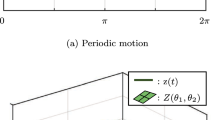Abstract
Using spectral, wavelet, multifractal, and recurrence analyses we examined the features of involuntary shaking (tremor) that occur during the performance of a given motor task. The task was to maintain the efforts of fingers under isometric conditions by a healthy subject, a patient with primary bilateral parkinsonism, and a patient with essential tremor syndrome. The physiological tremor was characterized by the lowest amplitude, a broad power spectrum, the lowest energy of the wavelet spectrum, the highest degree of multifractality, the lowest degree of determinism, and the highest entropy of the recurrence time density. In the case of the essential tremor we observed a significant enhancement of the wavelet spectrum energy and a decrease of the oscillation complexity. This was evident via the occurrence of clear peaks in the power spectra, a decrease in the degree of multifractality, the emergence of a quasi-periodic structure in the recurrence diagrams, an increase in determinism and a decrease of the entropy of recurrence time density. All these trends were increased for the parkinsonian tremor data. These characteristics enable us to quantitatively estimate the degree of deviation of motor function from the healthy case.
Similar content being viewed by others
References
McAuley, J.H. and Marsden, C.D., Physiological and pathological tremors and rhythmic central motor control, Brain, 2000, vol. 123, no. 8, p. 1545.
Elble, R.J., Characteristics of physiologic tremor in young and elderly adults, J. Clin. Neurophysiol., 2003, vol. 114, no. 4, p. 624.
Raethjen, J., Pawlas, F., Lindemann, M., et al., Determinants of physiologic tremor in a large normal population, J. Clin. Neurophysiol., 2000, vol. 111, no. 10, p. 1825.
Pavlov, A.N., Tupitsyn, A.N., Legros, A., et al., Using wavelet analysis to detect the influence of low frequency magnetic fields on human physiological tremor, Physiol. Meas., 2007, vol. 28, no. 3, p. 321.
Shtok, V.N., Levin, O.S., and Fedorova, N.V., Diagnostika i lechenie ekstrapiramidnykh rasstroistv (Diagnosis and Treatment of Extrapyramidal Disorders), Moscow: MIA, 2002.
Golubev, V.L. and Magomedova, R.K., The spectral analysis of the variability of frequency and amplitude characteristics of tremor in patients with essential tremor and tremulous form of Parkinson’s disease, Zh. Nevrol. Psikhiat. im. S.S. Korsakova, 2006, vol. 106, no. 1, p. 43.
Gresty, M. and Buckwell, D., Spectral analysis of tremor: Understanding the results, J. Neurol. Neurosurg. Psychiat., 1990, vol. 53, no. 11, p. 976.
Elble R.J. Essential tremor frequency decreases with time, Neurology, 2000, vol. 55, no. 10, p. 1547.
Hellwig, B., Mund, P., Schelter, B., et al., A longitudinal study of tremor frequencies in parkinson’s disease and essential tremor, Clin. Neurophysiol., 2009, vol. 120, p. 431.
Growdon, W., Ghika, J., and Henderson, J., Effects of proximal and distal muscles’ groups contraction and mental stress on the amplitude and frequency of physiological finger tremor. An accelerometric study, Electromyogr. Clin. Neurophysiol., 2000, vol. 40, no. 5, p. 295.
Dick, O.E., Romanov, S.P., and Nozdrachev, A.D., Energy and fractal characteristics of physiological and pathological tremors of the human hand, Hum. Physiol., 2010, vol. 36, no. 2, p. 203.
Dick, O.E. and Nozdrachev, A.D., Nonlinear dynamics of involuntary shaking of the human hand under motor dysfunction, Hum. Physiol., 2015, vol. 41, no. 2, p. 156.
Eckmann, J.P., Kamphorst, S., and Ruelle, D., Recurrence plots of dynamical systems, Europhys. Lett., 1987, vol. 4, no. 9, p. 973.
Marwan, N., Romano, M.C., Thiel, M., et al., Recurrence plots for the analysis of complex systems, Phys. Rep., 2007, vol. 438, p. 237.
Muzy, J.F., Bacry, E., and Arneodo, A., Multifractal formalism for fractal signals: The structure-function approach versus the wavelet-transform modulus-maxima method, Phys. Rev. E, 1993, vol. 47, p. 875.
Pavlov, A.N. and Anishchenko, V.S., Multifractal analysis of complex signals, Phys.-Usp., 2007, vol. 50, no. 8, p. 819.
Gao, J.B., Recurrence time statistics for chaotic systems and their applications, Phys. Rev. Lett., 1999, vol. 83, p. 3178.
Little, M.A., McSharry, P.E., Roberts, S.J., et al., Exploiting nonlinear recurrence and fractal scaling properties for voice disorder detection, BioMed. Eng. Online, 2007, vol. 6, p. 23.
Bedrov, Y.A., Dick, O.E., and Romanov, S.P., Role of signal-dependent noise during maintenance of isometric force, BioSystems, 2007, vol. 89, nos. 1–3, p. 50.
Dick, O.E. and Svyatogor, I.A., Potentialities of the wavelet and multifractal techniques to evaluate changes in the functional state of the human brain, Neurocomput. J., 2012, vol. 82, p. 207.
Derguzov, A.V., Makhortykh, S.A., and Semechkin, R.A., Complex diagnosis of Parkinson decease by means of magnetic encephalography, 2000 Issled. Ross. http://zhurnal.ape.relarn.ru/articles/2006/065.pdf
Anninos, P.A., Adamopoulos, A.V., Kotini, A., et al., Nonlinear analysis of brain activity in magnetic influenced Parkinson patients, Brain Topogr., 2000, vol. 13, no. 2, p. 135.
Müller, V., Lutzenberger, W., Preisl, H., et al., Complexity of visual stimuli and non-linear EEG dynamics in humans, Cognit. Brain Res., 2003, vol. 16, p. 104.
Brittain, J.S., Cagnan, H., Mehta, A.R., et al., Distinguishing the central drive to tremor in Parkinson’s disease and essential tremor, J. Neurosci., 2015, vol. 35, no. 2, p. 795.
Stam, C.J., Nonlinear dynamical analysis of EEG and MEG: Review of an emerging field, Clin. Neurophysiol., 2005, vol. 116, no. 10, p. 2266.
Stam, C.J. and de Bruin, E.A., Scale-free dynamics of global functional connectivity in the human brain, Hum. Brain Mapp., 2004, vol. 22, no. 2, p. 97.
Author information
Authors and Affiliations
Corresponding author
Additional information
Original Russian Text © O.E. Dick, A.D. Nozdrachev, 2016, published in Fiziologiya Cheloveka, 2016, Vol. 42, No. 3, pp. 47–55.
The article was translated by the authors.
Rights and permissions
About this article
Cite this article
Dick, O.E., Nozdrachev, A.D. Features of parkinsonian and essential tremor of the human hand. Hum Physiol 42, 271–278 (2016). https://doi.org/10.1134/S0362119716030063
Received:
Published:
Issue Date:
DOI: https://doi.org/10.1134/S0362119716030063




